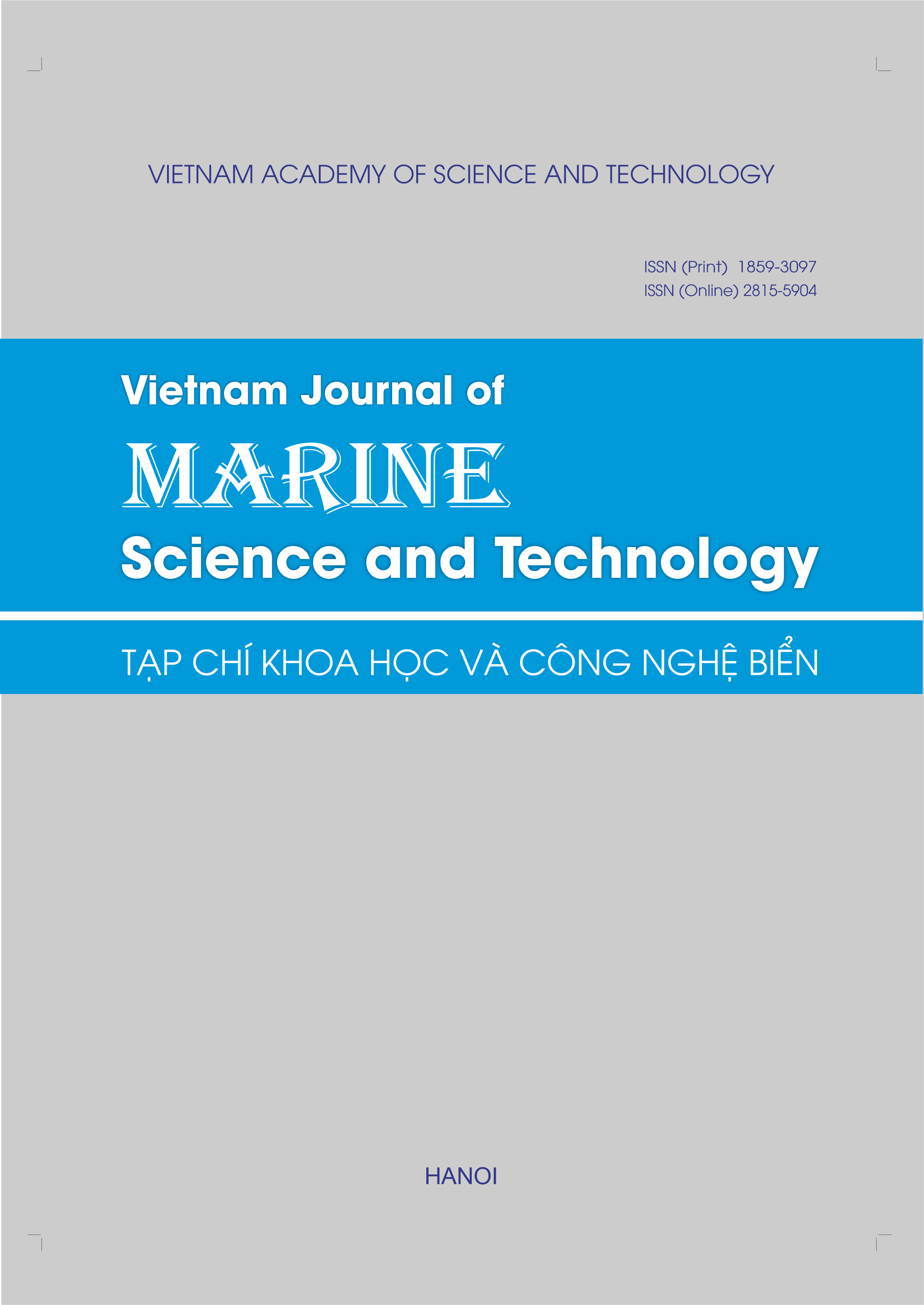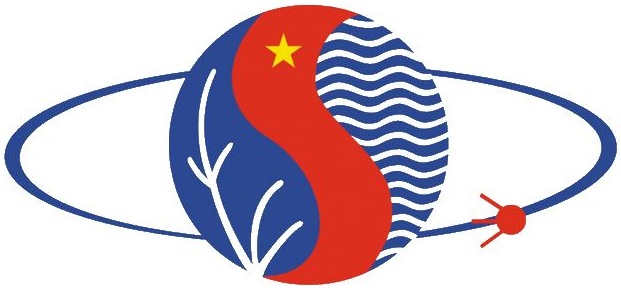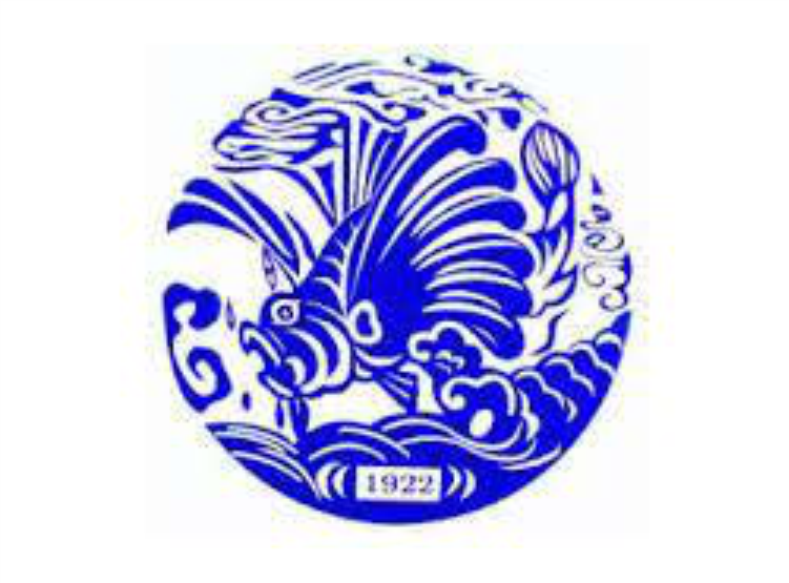Chemical constituents produced by the marine fungi Penicillium sp. M839 and their antimicrobial evaluation
Author affiliations
DOI:
https://doi.org/10.15625/1859-3097/22733Keywords:
Penicillium sp. M839, marine fungi, alkaloid, sterol, antimicrobialAbstract
From the agar-based culture of the marine-derived Penicillium sp. M839 strain, nine known compounds were isolated and structurally determined, including fumiquinazoline D (1), fumiquinazoline B (2), cerevisterol (3), stoloniferol B (4), norhaman (5), 3,4-dihydroxy-6,7-dimethyl-quinolin-2-carboxylic (6), uracil (7), 3-methyl uracil (8), thymine (9). These compounds were characterized via 1D and 2D NMR spectroscopic and mass spectrometric analyses. Compounds 2 and 8 were first recognized from the genus Penicillium, while the remaining compounds were previously isolated from this genus. Compounds 1–6 were evaluated for their antimicrobial activity against a panel of test microorganisms (three Gram-positive bacteria: Enterococcus faecalis, Staphylococcus aureus, Bacillus cereus; three Gram-negative bacteria: Escherichia coli, Pseudomonas aeruginosa, Salmonella enterica and one yeast strain Candida albicans). The results showed that compound 6 displayed strong antimicrobial activity against two Gram-negative bacteria E. coli and S. enterica, with the MIC values of 32 and 64 µg/mL, respectively. In addition, the remaining compounds 1–5 inhibited against all test microorganisms with MIC values ranging from 64 to 256 µg/mL.
Downloads
References
[1] S. Liu, M. Su, S.-J. Song, and J. H. Jung, “Marine-derived Penicillium species as producers of cytotoxic metabolites,” Marine Drugs, vol. 15, no. 10, 329, 2017. DOI: 10.3390/md15100329.
[2] M. Vansteelandt, C. Roullier, E. Blanchet, Y. Guitton, Y. F. Pouchus, N. Ruiz, and O. Grovel, “Impact of marine‐derived Penicillium species in the discovery of new potential antitumor drugs,” in Outstanding Marine Molecules, pp. 45–84, 2014. DOI: 10.1002/9783527681501.ch03.
[3] A. Kozlovskii, V. Zhelifonova, and T. Antipova, “Fungi of the genus Penicillium as producers of physiologically active compounds,” Applied Biochemistry and Microbiology, vol. 49, no. 1, pp. 1–10, 2013. DOI: 10.7868/s0555109913010091.
[4] T. D. Phi, T. L. Nguyen, T. Q. Vu, M. A. Nguyen, T. T. H. Vu, T. H. M. Le, V. C. Pham, and T. M. H. Doan, “Antimicrobial secondary metabolites from a marine-derived fungus Penicillium sp. OM07,” Vietnam Journal of Marine Science and Technology, vol. 24, no. 2, pp. 175–184, 2024. DOI: 10.15625/1859-3097/19564.
[5] J. M. Andrews, “Determination of minimum inhibitory concentrations,” Journal of Antimicrobial Chemotherapy, vol. 48, no. 1, pp. 5–16, 2001. DOI: 10.1093/jac/48. suppl_1.5.
[6] C. Takahashi, T. Matsushita, M. Doi, K. Minoura, T. Shingu, Y. Kumeda, A. Numata, “Fumiquinazolines A–G, novel metabolites of a fungus separated from a Pseudolabrus marine fish,” Journal of the Chemical Society, Perkin Transactions 1, no. 18, pp. 2345–2353, 1995. DOI: 10.1039/P1995 0002345.
[7] I. H. Hwang, Y. Che, D. C. Swenson, J. B. Gloer, D. T. Wicklow, S. W. Peterson, and P. F. Dowd, “Haenamindole and fumiquinazoline analogs from a fungicolous isolate of Penicillium lanosum,” The Journal of Antibiotics, vol. 69, no. 8, pp. 631–636, 2016. DOI: 10.1038/ja.2016.74.
[8] D. T. M. Nguyen, L. T. M. Do, H. T. N. Tuyet, M. K. Q. Ho, H. T. Nguyen, J. Mortier, and P. K. P. Nguyen, “Chemical constituents of the lichen Dendriscosticta platyphylloides, Lobariaceae,” Science and Technology Development Journal, vol. 22, no. 1,
pp. 165–172, 2019. DOI: 10.32508/stdj. v22i1.1219.
[9] T. Xinzh, “Isocoumarin derivatives from the sea squirt derived fungus Penicillium stoloniferum QY2-10 and the halotolerant fungus Penicillium notatum B52,” Archives of Pharmacal Research, vol. 30, no. 7,
pp. 816–819, 2007. DOI: 10.1007/BF02 978830.
[10] K. Yomosa, A. Hirota, H. Sakai, and A. Isogai, “Isolation of harman and norharman from Nocardia sp. and their inhibitory activity against plant seedlings [rice and lettuce],” Agricultural and Biological Chemistry (Japan), vol. 51, no. 3, pp. 921–923, 1987. DOI: 10.1271/bbb1961.51.921.
[11] Q. V. Thi, V. H. Tran, H. D. T. Mai, C. V. Le, M. L. T. Hong, B. T. Murphy, V. M. Chau, and V. C. Pham, “Antimicrobial metabolites from a marine-derived actinomycete in Vietnam’s East Sea,” Natural Product Communications, vol. 11, no. 1, 1934578X1601100116, 2016. DOI: 10.1177/1934578X1601100116.
[12] V. V. Nam, D. T. M. Huong, C. V. Minh, and P. V. Cuong, “Compounds from culture broth of marine bacterium Micromonospora sp. (G047),” Vietnam Journal of Chemistry, vol. 55, no. 2, 207, 2017. DOI: 10.15625/2525-2321.2017-00445.
[13] I. W. Still, N. Plavac, D. M. Mckinnon, and M. S. Chauhan, “Carbon-13 nuclear magnetic resonance spectra of N-, O-, and S-methylated uracil and thiouracil derivatives,” Can. J. Chem., vol. 56, no. 5, pp. 725–729, 1978. DOI: 10.1139/v78-120.
[14] C. K. Hoang, H. T. Tran, H. T. Tran, D. T. Hoang, and C. H. Le, “Cerevisterol and aloesol from a marine derived Penicillium fungus as potential topical cosmeceutical ingredients,” Preprint, 2023. DOI: 10.21203/rs.3.rs-3387447/v1.
[15] W. Wang, Y. Liao, B. Zhang, M. Gao, W. Ke, F. Li, Z. Shao, “Citrinin monomer and dimer derivatives with antibacterial and cytotoxic activities isolated from the deep sea-derived fungus Penicillium citrinum NLG-S01-P1,” Marine Drugs,
vol. 17, no. 1, 46, 2019. DOI: 10.3390/ md17010046.
[16] H. J. Yan, S. S. Gao, C. S. Li, X. M. Li, and B. G. Wang, “Chemical constituents of a marine-derived endophytic fungus Penicillium commune G2M,” Molecules, vol. 15, no. 5, pp. 3270–3275, 2010. DOI: 10.3390/molecules15053270.
Downloads
Published
How to Cite
Issue
Section
License
Copyright (c) 2025 Vietnam Academy of Science and Technology

This work is licensed under a Creative Commons Attribution-NonCommercial-NoDerivatives 4.0 International License.








